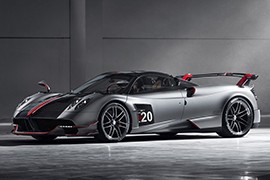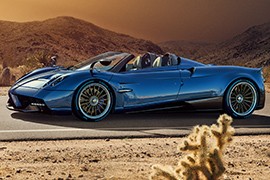PAGANI Huayra Roadster Models/Series Timeline, Specifications & Photos
First production year: 2017
Engines: Gasoline
Body style: Convertible (spider/spyder, cabrio/cabriolet, drop/open/soft top)
In 2017, Pagani made the track-oriented version of the Huayra and added the BC lettering to it to celebrate the company’s first customer, and two years later, it introduced the roadster of that extreme model.
Pagani quickly understood that some of its customers were racing their cars around tracks in friendly competitions, which drove other serious supercars and hypercars. The regular Huayra, even though it was highly competitive, lacked some features that could turn a fast car into a racer. As a result, the Italian car manufacturer made the BC version. The initials came from the company’s first customer, Banny Caiola, a personal friend of Mr. Horacio Pagani.
Like the coupe, the Roadster BC featured a different design than the non-BC version. The car manufacturer extensively used carbon fiber elements in and around the car. Even the removable roof was made out of this material and didn’t have glass on it, which made it 4 kilos (9 lbs.) lighter than the standard one used for the regular Huayra Roadster. At the front, the 2019 Huayra Roadster BC featured a different front bumper with a slightly enhanced two-level splitter that sported extended winglets. The car’s profile remained largely the same, but the most significant exterior difference, apart from the alloy wheels, was at the back of the car. There, Pagani installed a functional adjustable wing that allowed the car to corner faster than its non-BC sibling.
Inside, the cockpit featured the same comfortable, high-bolstered bucket seats. The mix of Alcantara, leather, and carbon fiber interior was enhanced by the addition of a wooden knob on the gear lever placed between the seats and with its linkages exposed. That was a trademark for the Italian automaker. Just like its non-BC sibling, the vehicle featured a binocular instrument cluster with two larger dials for the speedometer and tachometer, two gauges, and an LCD display in the middle. On the center stack, the car manufacturer placed two buttons that controlled the suspension and allowed customers to adjust it for road or track use.
But the most significant changes to the vehicle were on the technical side. Pagani used a new carbon fiber material that increased 12% in torsional rigidity and 20% in flexional rigidity. As a result, despite being an open-top vehicle, it offered a structural stiffness similar to a closed-coupe vehicle. The AMG-sourced twin-turbocharged V12 engine was similar to the one installed in the Huayra but provided some extra oomph and reached 800 PS (791 HP). It was mated to the same Xtrac transversely-mounted sequential seven-speed gearbox that sent the power to the rear wheels. The clutch assembly consisted of a lightweight flywheel and three discs since one couldn’t handle the massive 1,050 Nm (774 lb-ft) torque provided by the powerplant. Pagani made just 40 units of this open-top hypercar.
Years after the introduction of the Huayra, Pagani finally decided to cut off its roof and put out the Roadster version in 2017. Thee Huayra was unveiled at the Geneva Motor Show in 2017. The purpose was to achieve a lighter car than the coupe and Pagani managed to do that by using new materials, such as carbon-titanium used for the chassis. The Huayra Roadster’s weight was only 1280 kg.
The car did not borrow components from its predecessor, everything was changed for a more aggressive look. The car came with new alloy wheels, new tires specially made by Pirelli with the producer’s name, a new exhaust design and for the interior, new stitching designs were used. Buyers could choose between different themes and colors for the interior.
Some distinctive shapes can be seen in the front and rear where additional vents can be seen, especially on the humps above the engine. The Pagani Huayra Roadster is powered by the Mercedes-AMG M158 engine. The twelve-cylinder engine, built specifically for Pagani by Mercedes-AMG, has benefited from the research and development done for the Huayra BC, delivering a power of 764 HP at 6200 RPM, with a torque of over 1000 NM already available at 2400 RPM. Only 100 of Huayra Roadsters were manufactured and each of them was sold.

